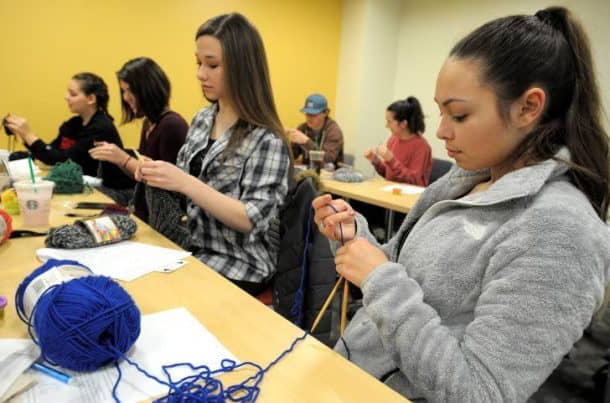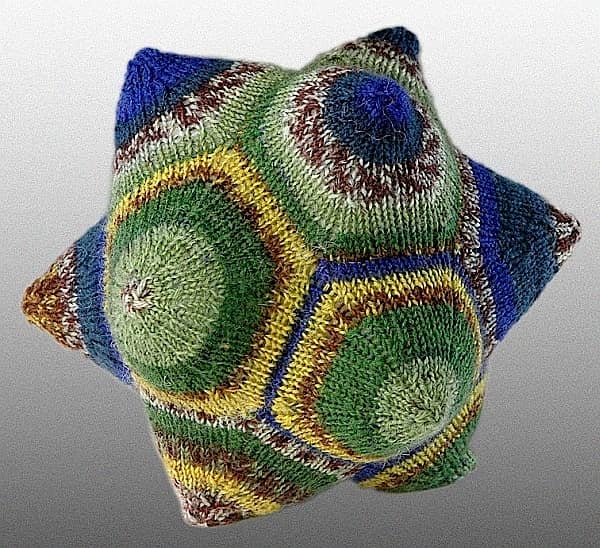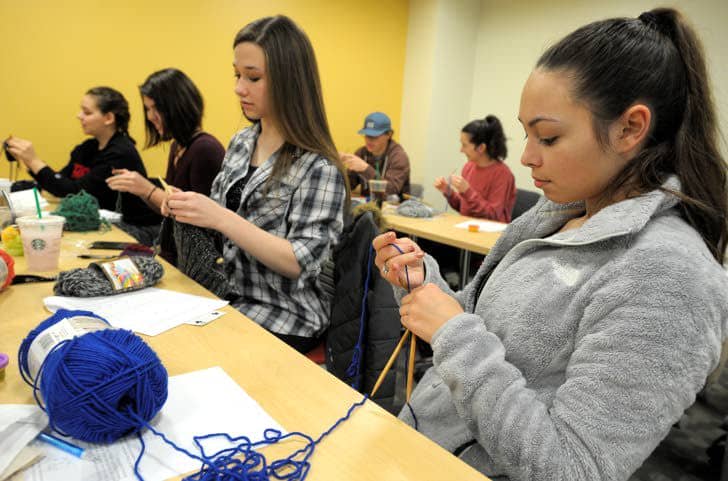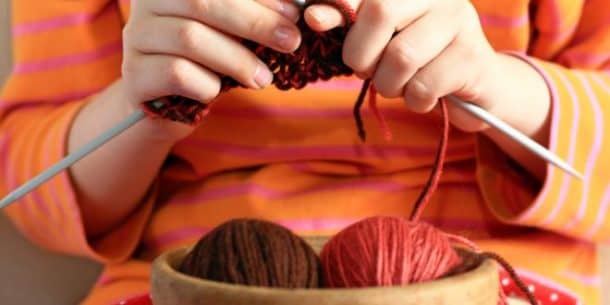Sara Jensen is a math professor who teaches math with knitting needles and wool instead of using the traditional calculators and textbooks. The assistant professor of Mathematics at Carthage College has a mission to get people to understand math as a method of better understanding of the world around them. The way she has adapted to teach is through knitting and by observing real-life objects.
Assistant professor of Mathematics, Jensen, shared her special math classes and results of teaching this way in a blog post. She began by recalling asking a group of college students to tell the first word that comes to their mind when they consider mathematics. She said that “calculation” and “equation” came as the top answers. When the same question was posted to professional mathematicians, they responded with “critical thinking” and “problem-solving.” She explained by saying, “What professional mathematicians think of as mathematics is entirely different from what the general population thinks of as mathematics. When so many describe mathematics as synonymous with calculation, it’s no wonder we hear “I hate math” so often.”

The Mathematics of Knitting class starts with students knitting throw cushions which demonstrates an essential aspect of mathematics, that is an equivalence. Jensen said that ‘fundamental to math is the equation, and crucial to this is the equal sign.’ She gave an example of x=5. Mathematically x has the same value as 5, which is the number 5 and the value of x must be the same. She says that in life, things are not always clear and often two quantities are not the same but are also essentially the same by some criteria.

To show this, students in her class knitted throw pillows and the patterns that they made on the pillows showed equivalence when moved around physically. She taught another topic through her craft called the ‘rubber sheet geometry’. This field asks the learner to imagine the whole world to be made of sheets of rubber and then reconsider what that means for shapes and topography. If you think this is difficult, then perhaps you can think of it with a knitting example. A way to create round objects like gloves or socks is with knitting needles called double pointed needles.
The hat is created using three pointed needles which make the object take the form of a triangle, however, once complete and the needles removed, the hat or glove softens and forms a circle. Rubber sheet geometry proposes that a triangle and a circle can be the same if they’re made out of a flexible material. In this field, all polygons can take the shape of a circle. Students in ‘The Mathematics of Knitting’ class spent the time to knit various scarves and other round objects to play around this theory. Jensen says that by using this teaching tools, she can open up the world of mathematics to a huge audience and can help them embrace mathematical thought in their daily life.
Here is another professor talking about the mathematics of knitting:




Enough with the needles, already!!!!!!! Sheesh. Fascinating article, I have always thought myself useless at math, yet knitting makes perfect sense to me. Nice to know I’m not crazy. Thank you.
Never been great at math, but love knitting.
Maybe hope for me yet
As a failure at math and a devoted struggling knitter this would be an awesome Great Course offering ! I ‘d like the pattern.
I just learned that one of the significant differences between mammals and dinosaurs was not just that mammals have hair, suckle their young and don’t lay eggs, but also that, like the knitting needles dismissed below, have teeth with more than one point. So while dinos have rows of identical teeth like knitting needles, a single mammalian tooth can have rows of cusps of differing form, giving the potential of subtle grinding of plant foodstuffs and making it possible for the mammals to inherit the Earth. So don’t deride the three-pointed needles! 🙂
Knitter of round things here: that’s “three double-pointed” needles, not “three-pointed needles”. The author was a little loose with her language is in the middle of the article so I understand why you were confused.
I just want the pattern, and how can there be so many comments that the word double was left out?
You’re correct – three double-pointed needles. And a fourth needle to do the knitting off the other three.
I have a couple sets of five double pointed needles?
You’re correct – three double-pointed needles. And a fourth needle to do the knitting off the other three.
Knitting and math
Waldorf education has been using knitting to help children learn since it’s inception in 1919! That’s 100 years!! It’s about time others educators started casting on!! Well done!!
Some of these comments are just plain knit-picky!
As a volunteer guide aboard HMS Victory I try to show our visitors the difference between a cable and a rope by using the difference between straight stitches and cable stitches in knitting so maybe the mathematics of different knitting stitches is also significant.
The “three pointed needle” sentence is actually what we call a garden path sentence. It is a phrase that can be parsed multiple ways. This clearly was a multipronged approach to get the point across. Weeding out the ambiguity would have made the readers possibly focus less on the parsing issue and more on the lovely intent of the article to value and report on delightful alternate teaching modalities.
Interesting
Why are people continuously commenting on the same thing ~ the “three pointed needles” ~ totally redundant because it has been solved…
i also wants to joim
The obsession with needles in this comment section is hilarious. It reads like a Monty Python skit. “This is a dead parrot!” “Maybe it’s just sleeping!”
I assume you have reread your post and noticed that the article says to use 3 double-pointed needles, and not 3 pointed needles?
Double pointed needles are used when knitting in the round, and are in fact double pointed. You can knit with 2,3,4 or even more double pointed needles.
When knitting in a triangle, as mentioned in the article, one works with 4 needles that are pointed on both ends. 3 hold the project and the 4th is used to work onto.
This is great. I am a passionate knitter and a passionatree Maths teacher. How about the use of repetitive patterns in knitting linked to patterns in Maths? One could do a lot with that – if only the powers that be didn’t wear blinkers.
Yes! I would love to take a class using math to project decreasing or increasing stitch patterns to design a project.
I second that
The article did not say three-pointed needles. It said three pointed needles. It is, however, still bad grammar, as all needles are pointed. The correct way would have been three double-pointed needles, which would have cleared any confusion.
I don’t know much about knitting, but I know more than a thing or two about mathematics. There are a few mistakes in this article, as others have pointed out. Here’s another: Topology is a field of mathematics, but topography is not. I think topography is a concept within the discipline of geography. Topology is the branch of mathematics that describes an equivalence between polygons and circles.
I don’t know much about knitting, but I know more than a thing or two about mathematics. There are quite a few mistakes in this article.
Topology is a field of mathematics, but topography is not. I think topography is a concept within the discipline of geography.
The paragraph about the ‘rubber sheet project ‘ makes it quite clear that they’re talking about topography – the physical appearance of the earth. It uses the image of the flexible sheet filling and covering natural indentations and undulations, much as a knitted garment fits the wearer. Mathematics plays an important role in topography.
Three pointed needles? That’s a good trick. I suppose you mean 3 double-pointed needles.
Three DOUBLE-pointed needles, three or four separate needles each of which have two points so that one may knit onto one end and off the other end in sequence to form a seamless round.
The poor proof reading job for this article distracts from it’s stellar content. This makes such great sense to me.
She meant 3 doublepointed neadels, 1+1+1. NOT neadels with 3 points..
Fabulous!
As a MS Math Teacher teaching basic 6th Grade Math, I find this fascinating. Do you have resources that I could access to use with my students? I do not know how to knit (at the moment); do you have other modes that you could also share? Thanks so much! Quite inspiring!
6th grade math leaves itself wide open to introduce different hand crafts with Math. I am currently schooling to be MS Math and fully intend to use arts and crafts as a BIG part of my teaching to everyday use also. Sewing –quilting specifically–uses SO much MS math you would be overwhelmed. Don’t forget gardens offer Math also.
A future’s method of teacing, learning of mathematics! From complexity of real world to a perfect abstract level of mathematics this is an optimal modelling approach!
Yea, knitting and non linear equations in math.Oh, we were doing that 15 years ago. But if it helps you learn….Of course, we should be asking WHAT did you learn.
“Three double pointed needles”. The needles are double pointed(have two points), and there are three of those needles.
At a Life Insurance Co. computer programmer meeting, I presented a page showing knitting insructions . The males present thought they were aa new but unidentified computer language !!
The problem here is that this is an elective “special topics” course. This is not a course designed to teach, for example, engineers Calculus. It is simply a filler course, but this gives the impression that students can learn all they need to know about Calculus in a course like this. It would take them 3 years to cover the necessary topics that are covered in a traditional course.
I guess just like when someone posts that “people are are good either at math or English.”
The hats are knitted on three double-pointed needles – there are no such thing as three pointed needles. Needles do not have three points. They can have a maximum of two. If there is a third, something horrible has happened that can probably be described with mathematics but it definitely won’t be fixed with knitting.
rm, the example is a mention of three (3) double – pointed needles used to make continuous rows of stitches.
Three double pointed needles – three needles, each with two (double pointed) points. Of course the needle doesn’t have two points
It is 3 double pointed needles, which is commonly used in knitting to knit a ‘tube’ with no joins
“Three DOUBLE-pointed needles” not three tri-pointed needles !
There are three needles used to hold the work/stitches and each of those needles has 2 points being double-pointed needles.
Tri-pointed needles do not technically exist , however , some needles , bent in the centre , which are used for cable knitting can appear to be tri-pointed to some effect.
“Three needles with points”, NOT “needles with three points”. It’s all in how you parse the sentence.
3 – double pointed needles – as in (3)- individual double pointed needles.
You are mis-reading. They are using a quantity of 3, double-pointed knitting needles. These are a standard knitting tool and are typically sold as a set of 5 needles. They are used to create smaller projects knit in the round. Larger projects get a circular needle. You can google such things.
Three double-pointed needles = 3 needles. Each of these is double-pointed, i.e. each needle has a point at either end.
It’s not referring to 3 pointed needles. The stitches are divided between three double pointed needles and knit with another double pointed needle
Pretty sure that was a typo. Clearly you are not a knitter. Lighten up .. And knit
It says “three DOUBLE-pointed needles”. The needles have two points each. They use three of them.
A “double pointed needle” is the name of the tool. Because it’s pointed at both ends, you can work on it both coming and going, as you do in knitting a loop. But I think the THREE is an error. You have the stitches spread across three needless, but need a fourth to work with, moving them around.
She said three double pointed needles not three pointed needles. Yes you can use 3 needles that are double pointed.
Three needles that are pointed.
3 pointed needle = 3 knitting needles, pointed at both ends. These needles hold the stitches and you use a forth needle to knit with. The needles themselves are called double pointed needles.
Three needles that are each double pointed is what the writer actually means. It doesn’t come across very well in the article!
When I read the article, I took it as saying that the hats are knitted on three needles that are pointed, not that the needles were three pointed. I believe that the article was saying the same thing you said. — the only difference is that you added the word “pointed” to the phrase. Three double-pointed needles versus three pointed needles.
Obviously the person who wrote this is not a knitter but I imagine she meant three needles with points (double ended) not three-pointed needles.
It’s 3 double pointed needles ie three needles that are double sided?
Three needles, that are pointed?
Three needles that are pointed. Perhaps you do not knit? Three needles are often used together in a project.
She meant 3 doublepointed neadels, 1+1+1. NOT neadels with 3 points..
They are not three pointed needles. They are three needles which each have two points. “Three double-pointed needles.”
Three knitting needles, each of which is double pointed. Commonly used for socks
Read your comment aloud. You’re answering your own question. The quantity of double pointed needles is three – not three point needles.
She does not say three pointed needles but 3 needles with double points, three double pointed needles, or 3 DPN’s
I think they mean three needles with two points/ends each 🙂
It means using three needles that are each double pointed. Obviously you know nothing about knitting.
LOL. I read it the same way at first. Perhaps a comma might have helped. The process uses three needles that are pointed. One makes a triangle of two-sided needles. 🙂
3 separate needles that have points on each end 🙂
Three double-pointed needles: three needles with a point at each end, rather than a regular knitting needle that only has a point at one end.
Too funny..
seriously? Three double pointed needles – THREE needles that are each double-pointed. How is that confusing?
I think it’s clear the hats at knit on 3- double
pointed needles.
Perhaps the sentence would make more sense it read “The hats are knitted on 3 double-pointed needles…” The needles themselves are double-pointed. Three needles are used to hold the knitted work. A fourth “free” needle is used to work the piece, moving it from one of the three onto the fourth, which then becomes the “free” needle to continue the work. I agree the sentence was awkwardly constructed… even as an experienced knitter, I had to read it twice. I think the idea, however, is genius. I always found math a very difficult subject as a child. As an adult who knits, sews, and crochets… I have become very comfortable with it (although I really need my calculator!).
They aren’t three pointed needles. They are using (3) double-pointed needles. That means that both ends of the needles have points. The work is knitted on the needle and can slide down to the other end of the needle to be worked off the other end. By sliding the work down and off the opposite end you can work it in a round instead of turning it. This eliminates the need to sew the piece up after and creates a much smoother finished product.
Look at you pointing out that the article writer probably isn’t a knitter! So edgy!
I assume you have reread your post and noticed that the article says to use 3 double-pointed needles, and not 3 pointed needles?
I believe they meant 3 needles-each of which are double pointed.
Three is a numerical adjective telling how many double-pointed needles are used, which is why she described the hat being triangular until it is removed from the needles.
Exactly!!!
It is 3 “double pointed” needles, not 3 pointed needles
This is great! But could you please edit the headline: it’s “advanced” mathematics, not, as you have it, “advance”. Thanks.
Here it is 2019 and they still haven’t fixed it. Maybe it is true what they say – that people are are good either at math or English…
Wait, who do you think wrote the title? Maybe a little critical thinking would help.
You know for someone complaining about spelling you think you would make sure your comment isn’t redundant. And one letter doesn’t really take away from the neat point this class is making and this article is presenting…
The typos are common in articles and memes. They do this because there’s something in Facebook algorithms that leads to more views.
Good morning one and all. OH non linear equations and knitting! I remember that! I did a few, then asked mysself, why am I doing this? Knitting should be fun. Heard a bit of wisdom about that. “You ain’t s**t, if you can’t knit. But you’re OK if you can crochet”.